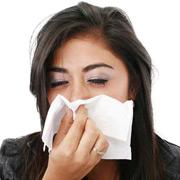Allergic rhinitis

On an annual basis, especially in the spring period, the scientific medical journals publish a range of material devoted to the prevalence rate, clinical symptoms, diagnostics and treatment of allergic rhinitis.
Allergic rhinitis is the most common medical problem in most countries. For the last several decades the steady growth of patients with this pathology is reported in various countries. According to the scheme of allergology diseases the ratio of the allergic rhinitis is quite high (60-70%). The occurrence of allergic rhinitis is associated with various limitations in physical, psychological and social parts of the human being. Allergic rhinitis makes people suffer most of their life and due to that the quality of life decreases and their day-to-day activity is interfered. Allergic rhinitis affects an estimated 35 mln natives of the USA per year with the evident symptoms of allergic rhinitis; the expenditure to treat allergic rhinitis totals about 3.5 bln US dollars per year.
The cost in direct medical care in Europe totals more than 1.5 bln Euro each year while indirect expenses are similar. The problem of allergic disease in Russia is similar to that. Up to 980 cases of this disease are reported per 100 tsd. population.
In the climatic and geographical conditions in Central Asia and in Uzbekistan, in particular the pollinosis with the rhinitis signs ranks first by the occurrence rate to make 88% cases, on the whole. Conjunctivitis ranks second with the figure of 54.4 %. In most cases all symptoms of pollinosis with rhinitis occur and resolve in the exacerbation stage. Rhinitis is classified into two kinds as follow:
- Seasonal allergic rhinitis etiologically caused by pollen allergens.
- Perennial allergic rhinitis. This form of rhinitis is triggered by airborne household, epidermal and other kinds of allergens. When the allergic rhinitis is caused by the house dust, the reason of it may appear as the exposure to dust mite in most cases. However, apart from these two kinds of rhinitis, the practice faces combined types of allergic rhinitis. Due to estimation of their etiological structure, positive results re revealed when in most cases human sensibilization is identified to three types of causative allergens (pollen + household + epidermal).
Rhinitis is classified into three types according to clinical symptoms: mild, moderate and severe.
The following clinical symptoms appear with all three types of rhinitis:
Paroxysmal sneezing followed by the abrupt of nasal breathing difficulty and profuse discharge from nose are reported to appear in most patients to diagnose pollen rhinitis.
Many patients complain on the headache, itching and burning sensation in nasal cavities and eyes, as well as on frequent paroxysmal sneezing.
Sneezing mechanism in such patients is paroxysmal appearing in 20 to 100 and more sneezes one by one. Such a tormenting sneeze occurs all of a sudden and appears several times a day When this occurs, the health condition of the patient deteriorates and the physician has to render medical help. Such physical condition is considered emergency allergenic.
The sneeze is followed by the abundant watery rheum from nose and the nasal breathing is obstructed. Patient always complain on the stuffiness in nose depending on the allergic edema of the nasal cavity mucosa. The color of the mucosa coating and discharge appearance in patients monitored by our physicians varied in types; the nasal cavity mucosa pattern was bright-red, crimson red, marble-white, of bluish discoloration, pale pink with ischemic traces; excretion pattern: watery, muculent, seromucous.
It can be concluded by the results of our work that the bright red color of the nasal mucosa coating ranks first, the crimson red ranks the second and the remaining coloration is less frequent. Nasal watery discharge is reported in 74 patients of the 125 under monitoring, the muculent discharge (rhinorrhea) is reported in 41 of them, and seromucous appearance is noted in 3 patients.
In parallel with the abovementioned symptoms, the patients also complain on the itching in nasopharynx, ears and hoarse voice. Moreover, signs of pollen intoxication are reported in pollinosis rhinitis, rhino-conjunctivitis, and atopic asthma. Most common symptoms of pollen intoxication in patients with pollinosis include headache, itching and burning sensation in nasal cavity and eyes, paroxysmal sneeze, nasal stuffiness, nasal stiffness. Apart from these intoxication symptoms, patients are reported to develop irritancy, appetite loss, heartquake, asthenia, precordialgia, paroxysmal cough, pallescence, congested pipes, asthma, hidrosis, faintness, tinnitus, abdominal pains, photophobia, body temperature increase occur.
Mild, moderate and severe clinical course vary in expression. In mild run of allergic rhinitis the symptoms and other signs occur only in morning hours and they quickly resolve. Symptoms of pollen intoxication are not visually observed.
Moderate allergic rhinitis is expressed in longer-lasting symptoms. The comfort of well-being disappears, the nasal breathing worsen, and the patient faces insomnia. Intoxication symptoms are relatively expressed. Antihistamine drugs show transient effect.
With the severe allergic rhinitis patients develop paroxysmal sneezing at a rate of 50 to 100 sneeze at a time. The strong rhinorrhea, the abundant discharge from nose, is developed (the patients bring lots of paper tissues on them), strong itching is irritable, the nasal breathing is obstructed in the day time and at night (especially at night) and the patient suffers from insomnia. Sometimes these symptoms are combined with dry coughing and irritation in the throat (pre-acute severe asthma). All symptoms of intoxication are expressed. Antihistamine drugs show no effect anticipated. In most cases in moderate and severe courses the nasal bleeding is observed. This likely occurs due to edema and hyperemia of nasal mucosa coating and nose vessels get easily permeable. In severe allergic rhinitis the rescue emergency care is required.
